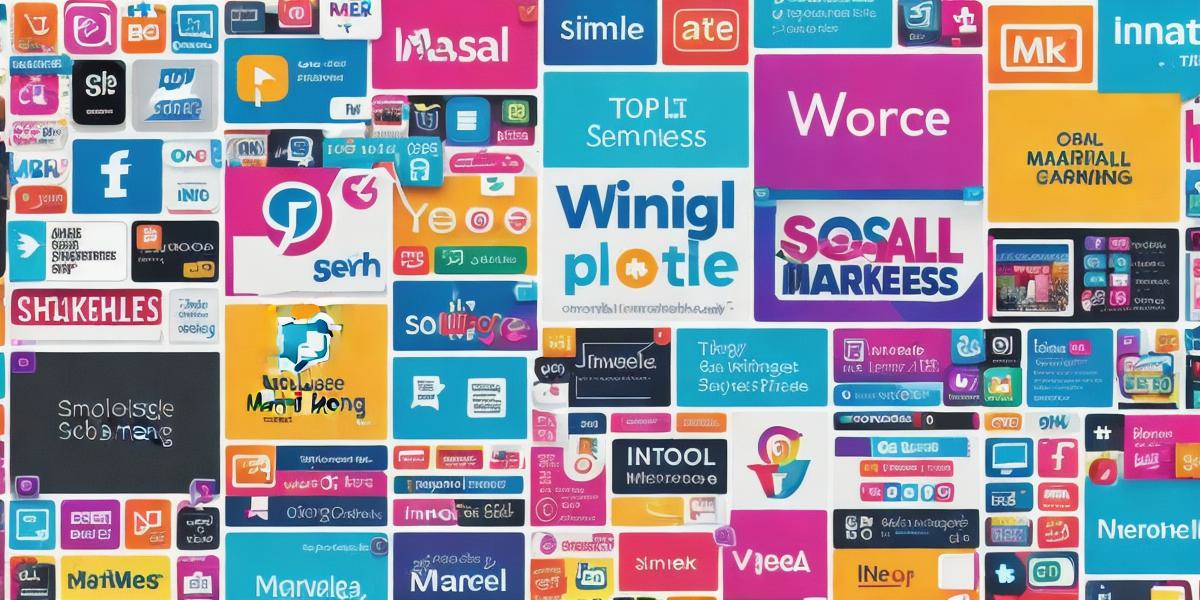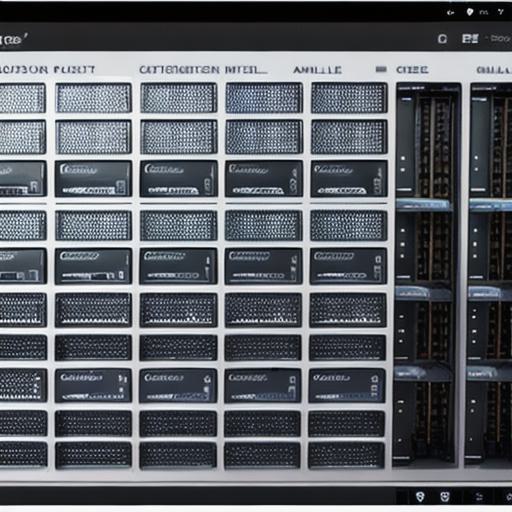Marketing is a crucial aspect of running a small business. It’s all about creating awareness of your brand, attracting new customers, and retaining existing ones. However, with so many marketing tools available, it can be overwhelming to choose the right ones for your business. In this article, we will explore the top 10 marketing tools that every small business needs to thrive.
Table of Contents
I. Introduction
- Brief overview of the article
* Importance of marketing for small businesses
II. Website Builders and Content Management Systems (CMS)
* Overview of website builders and CMS
* Advantages of using a website builder or CMS for small businesses
III. Search Engine Optimization (SEO)
* Definition of SEO
* Importance of SEO for small businesses
* How to optimize your website for search engines
IV. Social Media Marketing
* Overview of social media marketing
* Benefits of social media marketing for small businesses
* How to create a successful social media strategy
V. Email Marketing
* Definition of email marketing
* Advantages of email marketing for small businesses
* How to build an email list and create effective email campaigns
VI. Pay-Per-Click Advertising (PPC)
* Overview of PPC advertising
* Benefits of PPC advertising for small businesses
* How to set up and manage a PPC campaign
VII. Influencer Marketing
* Definition of influencer marketing
* Advantages of influencer marketing for small businesses
* How to find and work with influencers
VIII. Video Marketing
* Overview of video marketing
* Benefits of video marketing for small businesses
* How to create effective videos for your business
IX. Content Marketing
* Definition of content marketing
* Advantages of content marketing for small businesses
* How to develop a content marketing strategy
X. Analytics and Tracking Tools
* Overview of analytics and tracking tools
* Importance of tracking your marketing efforts
* How to use analytics tools to measure the success of your marketing campaigns
FAQs
I. Introduction
Marketing is essential for any business, but especially for small businesses that need to create awareness and attract new customers. With so many marketing tools available, it can be overwhelming to choose the right ones for your business. In this article, we will explore the top 10 marketing tools that every small business needs to thrive.
II. Website Builders and Content Management Systems (CMS)
Website builders and CMS are essential for creating a professional-looking website that represents your brand and attracts new customers. Website builders make it easy to create a website without any technical knowledge, while CMS allow you to manage and update the content on your website easily. Some of the top website builders and CMS include WordPress, Wix, Squarespace, and Shopify.
Advantages of using a website builder or CMS for small businesses:
- Cost-effective: Website builders and CMS are affordable and allow you to create a professional-looking website without breaking the bank.
- Easy to use: Website builders and CMS are user-friendly and do not require any technical knowledge, making it easy to create and manage your website.
- Customizable: Website builders and CMS offer a variety of templates and customization options, allowing you to create a website that represents your brand and attracts new customers.
III. Search Engine Optimization (SEO)
Search engine optimization (SEO) is the process of optimizing your website for search engines so that it ranks higher in search results and attracts more traffic. SEO involves optimizing your website’s content, structure, and keywords to make it easier for search engines to understand and rank your website. Some of the top SEO tools include Google Analytics, Ahrefs, SEMrush, and Moz.
Importance of SEO for small businesses:
- Increases visibility: SEO can help increase your website’s visibility in search results, making it easier for potential customers to find your business.
- Drives traffic: SEO can help drive more traffic to your website, increasing the number of potential customers who can learn about your products and services.
- Builds credibility: A well-optimized website can help build credibility and trust with potential customers, making it easier for them to do business with your company.
How to optimize your website for search engines:
- Conduct keyword research: Identify the keywords that potential customers use when searching for products and services like yours and incorporate them into your website’s content and meta tags.
- Optimize your website’s structure: Ensure that your website is easy to navigate and has a clear hierarchy of pages, making it easier for search engines to understand and rank your website.
- Create high-quality content: Create high-quality, relevant, and useful content that provides value to potential customers, as this can help improve your website’s ranking in search results.
IV. Social Media Marketing
Social media marketing is the process of using social media platforms like Facebook, Instagram, Twitter, and LinkedIn to promote your products and services, engage with your audience, and build brand awareness. Social media marketing can be an effective way for small businesses to reach new customers, increase brand visibility, and build relationships with their existing customers.
Benefits of social media marketing for small businesses:
- Increases brand visibility: Social media platforms allow you to reach a larger audience and increase the visibility of your brand.
- Builds relationships: Social media platforms provide an opportunity to engage with your customers and build relationships with them, helping to foster loyalty and repeat business.
- Drives traffic: Social media marketing can help drive traffic to your website, increasing the number of potential customers who can learn about your products and services.
How to create a successful social media strategy:
- Define your target audience: Identify the demographics of your target audience, including age, gender, interests, and location, so that you can tailor your content and messaging to their needs.
- Choose the right platforms: Select the social media platforms that your target audience uses the most, such as Facebook for older audiences or Instagram for younger audiences.
- Develop a content strategy: Create a content calendar that outlines the type of content you will create, the topics you will cover, and the frequency of your posts.
- Engage with your audience: Respond to comments, messages, and reviews promptly and engage with your audience to build relationships and foster loyalty.
V. Email Marketing
Email marketing is the process of sending emails to a list of subscribers to promote products and services, share updates, and build brand awareness. Email marketing can be an effective way for small businesses to reach new customers, increase repeat business, and build relationships with their existing customers.
Advantages of email marketing for small businesses:
- Cost-effective: Email marketing is an affordable way to reach a large audience without breaking the bank.


- Targeted: You can segment your email list based on demographics, interests, and behavior, allowing you to send targeted messages that are more likely to resonate with your audience.
- Measurable: Email marketing allows you to track the performance of your campaigns, including open rates, click-through rates, and conversions, so that you can optimize your strategy for better results.
How to build an email list:
- Offer a lead magnet: Provide a free resource or incentive in exchange for email addresses, such as an ebook, whitepaper, or webinar.
- Use pop-ups and forms: Add pop-ups and forms to your website to capture email addresses from visitors who are interested in your products and services.
- Partner with other businesses: Collaborate with complementary businesses to exchange email lists and reach new audiences.
VI. Content Marketing
Content marketing is the process of creating and sharing high-quality, relevant, and useful content that provides value to potential customers, helping to build brand awareness and drive traffic to your website. Content marketing can take many forms, including blog posts, infographics, videos, and social media posts.
Advantages of content marketing for small businesses:
- Builds trust: High-quality content that provides value to potential customers can help build trust and credibility with your audience.
- Increases visibility: Content marketing can help increase the visibility of your brand by attracting backlinks, social media shares, and other forms of organic traffic.
- Drives traffic: Well-optimized content can help drive traffic to your website, increasing the number of potential customers who can learn about your products and services.
How to create a content marketing strategy:
- Identify your target audience: Determine the demographics of your target audience, including age, gender, interests, and location, so that you can tailor your content and messaging to their needs.
- Define your goals: Identify the specific objectives of your content marketing strategy, such as increasing website traffic, building brand awareness, or generating leads.
- Develop a content calendar: Create a content calendar that outlines the type of content you will create, the topics you will cover, and the frequency of your posts.
- Measure your results: Track the performance of your content marketing campaigns using analytics tools like Google Analytics to determine what’s working and adjust your strategy accordingly.
VII. Paid Advertising
Paid advertising is the process of placing ads on social media platforms, search engines, or other websites to promote products and services, generate leads, and build brand awareness. Paid advertising can be an effective way for small businesses to reach new customers quickly and drive immediate traffic to their website.
Advantages of paid advertising for small businesses:
- Targeted: You can target your ads to specific demographics, interests, and behaviors, ensuring that your message reaches the right audience.
- Cost-effective: Paid advertising can be an affordable way to reach a large audience quickly without breaking the bank.
- Measurable: Advertising platforms provide detailed analytics that allow you to track the performance of your campaigns and optimize your strategy for better results.
How to create a paid advertising campaign:
- Define your target audience: Determine the demographics, interests, and behaviors of the people you want to reach with your ads.
- Set your objectives: Identify the specific goals of your paid advertising campaign, such as increasing website traffic, generating leads, or building brand awareness.
- Choose your ad format: Select the type of ad that best suits your objectives and target audience, such as display ads for brand awareness or video ads for product demonstrations.
- Set your budget: Determine how much you are willing to spend on your advertising campaign and allocate your budget accordingly.
VIII. Influencer Marketing
Influencer marketing is the process of partnering with social media influencers who have large followings and high engagement rates to promote products and services, build brand awareness, and reach new audiences. Influencer marketing can be an effective way for small businesses to leverage the power of social media to reach new customers and increase brand visibility.
Advantages of influencer marketing for small businesses:
- Increases credibility: Partnering with influencers who have a large following and high engagement rates can help increase the credibility and trust of potential customers.
- Reaches new audiences: Influencers often have followers that are outside of your target audience, allowing you to reach new customers and expand your reach.
- Builds relationships: Partnering with influencers can help build long-term relationships with customers and increase brand loyalty.
How to find the right influencer:
- Identify your target audience: Determine the demographics of your target audience, including age, gender, interests, and location, so that you can find influencers who have a large following in that niche.
- Use social media tools: Social media platforms like Instagram and Facebook provide tools to search for influencers based on their engagement rate, follower count, and other metrics.
- Reach out to influencers directly: Contact influencers directly through their social media profiles or email addresses to discuss potential partnerships.




